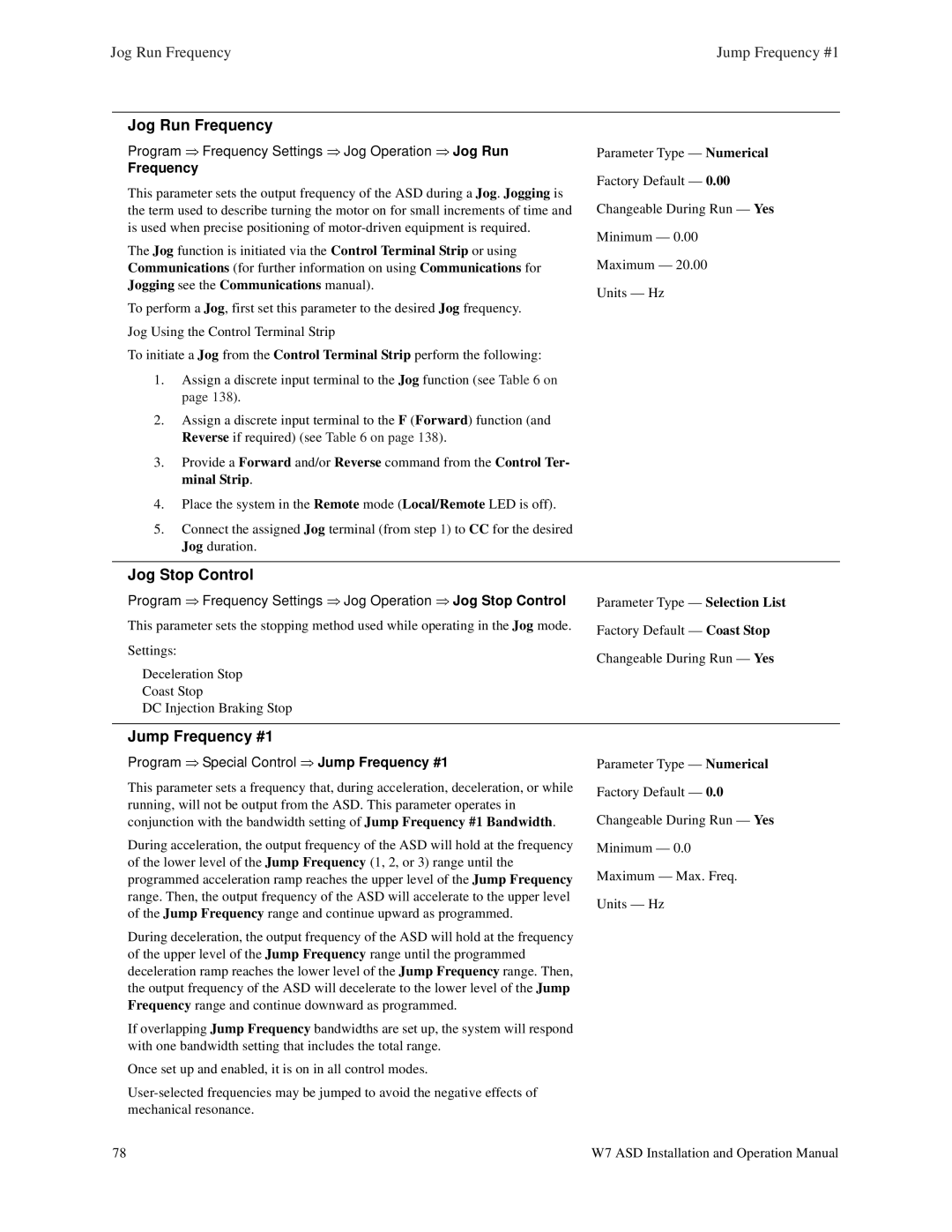
Jog Run Frequency | Jump Frequency #1 |
Jog Run Frequency
Program Frequency Settings Jog Operation Jog Run
Frequency
This parameter⇒sets the output frequency⇒⇒of the ASD during a Jog. Jogging is the term used to describe turning the motor on for small increments of time and is used when precise positioning of
The Jog function is initiated via the Control Terminal Strip or using Communications (for further information on using Communications for Jogging see the Communications manual).
To perform a Jog, first set this parameter to the desired Jog frequency. Jog Using the Control Terminal Strip
To initiate a Jog from the Control Terminal Strip perform the following:
1. Assign a discrete input terminal to the Jog function (see Table 6 on page 138).
2. Assign a discrete input terminal to the F (Forward) function (and Reverse if required) (see Table 6 on page 138).
3. Provide a Forward and/or Reverse command from the Control Ter- minal Strip.
4. Place the system in the Remote mode (Local/Remote LED is off).
5. Connect the assigned Jog terminal (from step 1) to CC for the desired Jog duration.
Parameter Type — Numerical
Factory Default — 0.00
Changeable During Run — Yes
Minimum — 0.00
Maximum — 20.00
Units — Hz
Jog Stop Control
Program Frequency Settings Jog Operation Jog Stop Control | Parameter Type — Selection List |
This parameter sets the stopping method used while operating in the Jog mode. | Factory Default — Coast Stop |
| |
Settings: | Changeable During Run — Yes |
| |
Deceleration Stop |
|
Coast Stop |
|
DC Injection Braking Stop |
|
Jump Frequency #1
Program Special Control | Jump Frequency #1 | Parameter Type — Numerical |
⇒ | ⇒ |
|
This parameter sets a frequency that, during acceleration, deceleration, or while | Factory Default — 0.0 | |
running, will not be output from the ASD. This parameter operates in | Changeable During Run — Yes | |
conjunction with the bandwidth setting of Jump Frequency #1 Bandwidth. | ||
During acceleration, the output frequency of the ASD will hold at the frequency | Minimum — 0.0 | |
of the lower level of the Jump Frequency (1, 2, or 3) range until the | Maximum — Max. Freq. | |
programmed acceleration ramp reaches the upper level of the Jump Frequency | ||
range. Then, the output frequency of the ASD will accelerate to the upper level | Units — Hz | |
of the Jump Frequency range and continue upward as programmed. |
| |
During deceleration, the output frequency of the ASD will hold at the frequency |
| |
of the upper level of the Jump Frequency range until the programmed |
| |
deceleration⇒ramp reaches the lower⇒level of the Jump ⇒Frequency range. Then, |
| |
the output frequency of the ASD will decelerate to the lower level of the Jump |
| |
Frequency range and continue downward as programmed. |
| |
If overlapping Jump Frequency bandwidths are set up, the system will respond |
| |
with one bandwidth setting that includes the total range. |
| |
Once set up and enabled, it is on in all control modes. |
| |
| ||
mechanical resonance. |
|
|
78 |
| W7 ASD Installation and Operation Manual |
